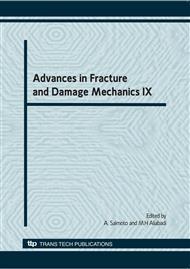p.81
p.85
p.89
p.93
p.97
p.101
p.105
p.109
p.113
Anisotropic Plastic Deformation and Damage in Commercial Al 2198 T8 Sheet Metal
Abstract:
Deformation anisotropy of sheet aluminium alloy 2198 (Al-Cu-Li) has been investigated by means of mechanical testing of notched specimens and Kahn-type fracture specimens, loaded in the rolling direction (L) or in the transverse direction (T). Contributions to failure are identified as growth of initial voids accompanied by a significant nucleation of a second population of cavities and transgranular failure. A model based on the Gurson-Tvergaard-Needleman (GTN) approach of porous metal plasticity incorporating isotropic voids, direction-dependent void growth, void nucleation at a second population of inclusions and triaxiality-dependent void coalescence has been used to predict the mechanical response of test samples. The model has been successfully used to describe and predict the direction-dependent deformation behaviour, crack propagation and, in particular, toughness anisotropy.
Info:
Periodical:
Pages:
97-100
Citation:
Online since:
November 2010
Authors:
Keywords:
Price:
Сopyright:
© 2011 Trans Tech Publications Ltd. All Rights Reserved
Share:
Citation:


